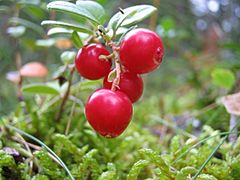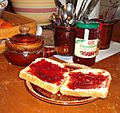Lingonberry facts for kids
Quick facts for kids Vaccinium vitis-idaea |
|
|---|---|
 |
|
| Conservation status | |
|
Conservation status: Secure
|
|
| Scientific classification | |
| Kingdom: | |
| Division: | |
| Class: | |
| Order: | |
| Family: | |
| Genus: | |
| Species: |
V. vitis-idaea
|
| Binomial name | |
| Vaccinium vitis-idaea |
|
Vaccinium vitis-idaea (also called the lingonberry, partridgeberry, mountain cranberry or cowberry) is a small evergreen shrub that produces edible fruits. These tasty red berries grow in cool, northern parts of the world. Lingonberries are related to cranberries and blueberries. They are known for their slightly tart but sweet flavor. People enjoy them in many dishes, especially jams and sauces.
Contents
What is a Lingonberry?
The lingonberry plant is a small, low-growing shrub. It stays green all year round, even in winter. This makes it an evergreen plant. It usually grows to be about 10 to 40 centimeters tall. The leaves are small, oval-shaped, and have a shiny, dark green color.
Where Lingonberries Grow
Lingonberries love cold places. They are found across the Northern Hemisphere. You can find them in Europe, Asia, and North America. They often grow in coniferous forests, on moorlands, and in tundra regions. These plants are very tough. They can survive harsh winters and poor soil conditions.
What Lingonberries Look Like
The flowers of the lingonberry plant are bell-shaped. They are usually white or pale pink. They grow in small clusters. After the flowers bloom, small green berries start to form. As they ripen, these berries turn a bright, shiny red color. They are usually about 6 to 10 millimeters wide.
Life Cycle of a Lingonberry
Lingonberry plants are perennial plants. This means they live for many years. They grow slowly but steadily.
How Lingonberries Reproduce
Lingonberries reproduce in a few ways. They produce seeds from their flowers. These seeds can grow into new plants. The plants also spread using underground stems called rhizomes. These rhizomes send up new shoots, creating new plants nearby. This helps them form dense patches.
Growing Season
Lingonberry flowers usually appear in late spring or early summer. The berries then ripen in late summer or early autumn. This is when they are ready to be picked. In some areas, there might even be a second, smaller harvest later in the fall.
Uses of Lingonberries
Lingonberries are very popular, especially in Nordic countries. They are known for their unique taste and health benefits.
Culinary Uses
Lingonberries are often used in cooking. They are commonly made into jams, sauces, and juices. In Sweden, lingonberry jam is a staple. It is served with many traditional dishes. These include meatballs and pancakes. The berries can also be eaten fresh. They are sometimes used in desserts or as a topping for yogurt.
Health Benefits
Lingonberries are packed with vitamin C and antioxidants. Antioxidants help protect your body's cells. They are also a good source of dietary fiber. Eating lingonberries can be a healthy part of your diet.
Images for kids
-
Lingonberry jam on toast
See also
 In Spanish: Vaccinium vitis-idaea para niños
In Spanish: Vaccinium vitis-idaea para niños







